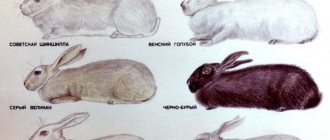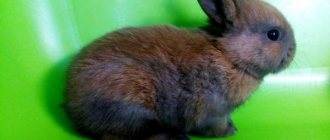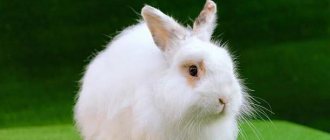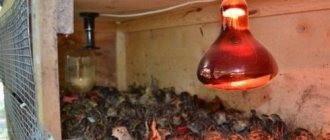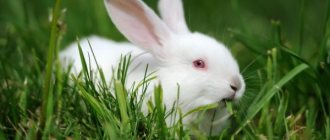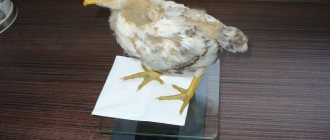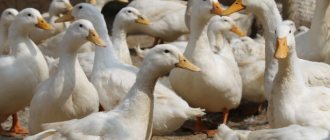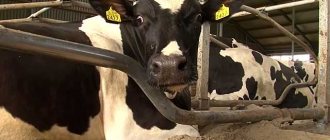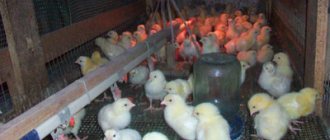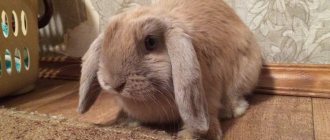Selection of popular breeds
There are many breeds of rabbits suitable for home keeping. For ease of grooming, it is better to give preference to varieties with short hair and small body size.
Most often, professionals advise choosing the following types.
Dutch
This breed was developed in the Netherlands. They are distinguished by their two-tone color. Eye color determines the coloring of certain areas of the head and back of the body. The front area and toes of the feet are usually white. The contrast boundary is clear.
The first official descriptions of this species appeared in the 19th century, but it is believed that the breed was developed much earlier - in the 15th century.
These cute and affectionate pets get along well with people and are not aggressive towards children. The size of the rabbit is small, maximum weight is about 2 kg. There are many colors - more than 20.
Dutch Fold
They differ from the previous breed in that the ears are not too long, hang down, but do not touch the floor. May be solid color. They are non-aggressive and get along well in an apartment. One of the smallest in size among ornamental breeds.
Dwarf Fold Rams
They are distinguished by hanging ears, an average length of the coat with an undercoat, and quite large sizes - up to 3 kg. The name of the breed is due to the steep, convex forehead of the individuals. These pets are calm, slow, not cowardly, easy to care for and do not show any aggression.
Also read the article about Ram rabbits.
Colored rabbits (dwarf shorthair)
A very small breed, the maximum weight of adults rarely reaches 1.5 kg. The ears are short, erect, and often have a different color from the main color. There are more than 60 shades of color in total.
The most popular variety is the white Oto, with a single black mark on a snowy background.
Curious and active pets are capable of showing some aggression only during the rutting period.
Pygmy foxes
The small breed (up to 1.2 kg) is covered with fairly long hair (from 3 to 7 mm), only it is shorter on the head. Three colors are common - chinchilla, brown and agouti, but other color variations are also found.
They need high-quality care; individuals can vary greatly in character; there are both calm and restless types of temperament.
Angora
Most varieties of this breed have fur so thick and long that the eyes and nose are not visible. Preference should be given to varieties with smooth, short and shiny hair (up to 5 mm). These are calm pets, well compatible with humans, but the peculiarity of the skin requires careful care.
Read more here.
Dwarf rex
There are a lot of representatives of decorative rabbits with wavy fur. The fur of these pets requires special care.
A lot has been written about Rex rabbits here.
Lion head
This variety is distinguished by the fact that the hair on the head is longer than on the rest of the body. There are many colors, weight and body size are small.
The character of these pets is calm and peaceful. They are able to play with children and do not show aggression towards them.
Also read about Lionhead Rabbit.
Hermelinas
These breeds are very popular in Europe, but are rare in Russia. The weight of individuals rarely reaches 1.2 kg. The color is only snow-white without yellowness. The ears are short and erect. Fur length no more than 2 mm. The short snub nose allows us to draw an analogy with the cat Persian.
They do not tolerate high temperatures well. They are unpretentious in care, but have a rather complex temperament.
More about Hermelina.
Japanese dwarfs
Small pets of various colors are distinguished by long, downy fur. They are very beautiful, but require special care.
Pygmy hare
One of the most common decorative breeds. Medium-sized pets are born completely white; with age, chaotically scattered spots of different colors appear on the body.
Angora lions
It is distinguished by the longest fur among decorative breeds, evenly covering the entire body, even the ears. The color is light red. If the hair grows significantly, it needs a haircut.
These are calm and leisurely pets, almost never showing signs of aggression (with the exception of the rut).
Dwarf butterflies
One of the most popular decorative types. Small rabbits rarely reach 1.5 kg. The shiny short coat has a peculiar pattern - ears, the area around the nose, a wide eye rim, a line in the middle of the back and a scattering of small spots on the sides, usually black or dark in color, and the main background is light or white. The color is symmetrical, and markings on the belly, legs or chest are considered defects. They get along well with people.
Squirrels
The young breed is similar in appearance to these animals and most often the same color. Calm pets are usually medium in size. There are few in Russia.
When choosing a rabbit for home keeping, it is better to consult with specialists, as some breeds are quite aggressive, especially towards children.
Photo gallery of decorative rabbits:
Also read about different breeds of rabbits.
Pygmy hare
White fur with small dark spots on the body and legs, ears and tail is a distinctive feature of the dwarf hare. Red eyes and pointed ears make this breed even more attractive. The rabbit weighs no more than 2 kg.
By nature, pets are a little timid, but they are always kind and loving towards their owner.
Content Basics
To properly maintain these decorative pets, you need to purchase various items and accessories, as well as learn how to use them correctly.
It is unacceptable to simply bring home a miniature pet and let it wander around the apartment on its own. In this case, both the animal and the household will have problems.
Rabbit house
For a small decorative rabbit, you need to purchase a cage measuring no less than 60 by 80 cm. Install it in the apartment so that direct sunlight does not fall on it and there are no drafts. The corner should not be cold or steam heated. The pet needs comfortable accommodation.
Also read about how to make your own rabbit cage.
A drinking bowl and feeding trough are installed in the house; they should always be clean.
Cleaning for rabbits is necessary regularly to prevent the appearance of an unpleasant odor in the apartment. Periodically carry out a general cleaning of the cage.
It is better not to use chemical disinfectants, so as not to poison the baby, but to use warm water and vinegar.
Thermal mode
Overheating and hypothermia of this pet are unacceptable.
The optimal temperature for living in an apartment or house is +18…+20°C.
The room should be ventilated daily to prevent high humidity, stagnant air and musty smell.
In the hot season, rabbits are prone to overheating; you can reduce it and help your pets by wrapping their ears with a cloth moistened with cool water. Large vessels responsible for thermoregulation of the entire body pass through here.
Hygiene
In a cage for a decorative rabbit, a tray with natural filling is usually installed - soft shavings, sawdust, wood chip pellets. It should be changed as it gets dirty, preferably daily. This pet is highly clean and will not use anything dirty.
If there is no toilet, you will have to frequently change the hay and bedding.
Mr. Tail recommends: walking
A decorative rabbit cannot be kept in a cage all the time. It is advisable to let him out every day under strict human supervision to walk around the apartment or one room for at least 30 minutes. At this time, you need to make sure that he does not chew furniture or wires, and remove all dangerous objects and chemicals from the access area. The cage door should not be closed so that the rabbit can return to the house at any time.
In the summer, at the dacha, you can make a small enclosure on the grass, providing it with a room in the shade where the pet can hide from direct sunlight.
Methods for keeping rabbits
Benefits of keeping rabbits in cages
This method of keeping rabbits has many advantages. Let's look at some of them:
- Portability. The cages can be moved anywhere in the house without much effort;
- Strength. Rabbits love to sharpen their teeth on something hard, but in the case of a metal cage they will have little success;
- Easy to catch. The rabbit is quite comfortable and can be easily taken out of the cage;
- Durability of the structure. The cage will serve you faithfully for many years;
- Good ventilation. Indoor spaces can spread a huge number of infectious diseases. In the case of a cage, such problems will not arise.
Advantages of keeping rabbits in kennels
The advantages of keeping rabbits in enclosures include:
- Change in animal behavior. Their anger and apathy disappear.
- Huge free space for the rabbit to play and have fun.
- Due to excessive activity, animals' appetite improves.
- Rabbits living in enclosures do not need to be vaccinated, unlike animals that live in cages.
- Rabbits feel much safer in enclosures than in cages.
Floor keeping of rabbits
The ability to move a lot has a beneficial effect on the character and health of animals. On the street, rabbits become calmer and aggression disappears. The offspring grow strong and even, since females feed not only their own, but also other people's rabbits.
On the street
Those who decide to keep rabbits in enclosures should carefully prepare for winter. Despite the fact that animals have thick and warm fur, they also need comfortable living conditions. Fluffies are able to withstand short-term temperature drops down to -17° Celsius.
When choosing this option for keeping rabbits in winter, you should take into account that a young rabbit has increased sensitivity to cold. Babies are born bald and defenseless. To prevent them from dying, you should arrange the queen cell, taking care of heating.
Sheds
Among the obvious advantages of shad it should be noted:
- Simplicity and ergonomic design. Even a beginner can take on the task of creating shad. Having the drawings and available tools, he can easily cope with this building, adjusting its parameters to his site;
- Constant access to fresh air. The main advantage of sheds is that they allow you to keep rabbits outside, while at the same time giving the animals reliable protection from drafts, direct sunlight, showers and other vagaries of the weather.
You should pay close attention to the arrangement of your rabbits' home.
Solving problems with sexual behavior
As a rule, all decorative breeds have a calm character and get along well with people. Some manifestations of aggression are possible during the rutting period. Therefore, if breeding is not planned, it is better to neuter your pets at a young age. As a rule, such individuals live much longer and do not have health problems.
In addition, adult unsterilized males will definitely mark.
Also read the article on how to determine the sex of a rabbit.
Who to choose: female or male
Rabbits can be kept alone. It is believed that females behave more calmly and reservedly, while males are sociable and playful. However, this is not quite true. Sociability, friendliness and affection are formed not by gender, but by innate temperament and upbringing. Both females and males can be both gentle and aggressive in response to a certain attitude towards them. They can also show aggression during puberty. Both males and females mark their territory.
If you plan to keep several individuals, then you need to choose a pair of different sexes, but take into account the fact that in this case, upon reaching puberty, they will begin to breed. If this is not in the plans, then the boy will have to be castrated upon reaching 6 months of age.
2 females also get along well. But the boys will not be able to get along peacefully. Having reached adulthood, they will begin to divide the territory, which will not happen without fights, which means wounds and torn out pieces of fur.
The sex of rabbits is determined by their genitals. In females, next to the anus there is a genital slit in the form of a pink loop. In males, the genital organ is located further from the anus. It looks like a curved process.
Important! A decorative rabbit must be purchased at 2
–
2.5 months of age from a trusted breeder or in a pet store, making sure that its exterior meets the standards and health.
Rules for caring for decorative rabbits
Each breed of decorative rabbits has its own characteristics, but you should know the general rules for caring for these pets:
- You should not bathe rabbits often; they are usually able to take care of their own fur coat. Every bath is stressful for pets, and in addition, the natural protective lubricant is washed away. After walking in the fresh air, it is enough for kids to wash or dry their paws.
- Decorative rabbits must be combed regularly, otherwise they will swallow a lot of hair while licking, which will lead to the formation of hairballs and problems with the gastrointestinal tract. To prevent them, you should feed them a special paste once every two weeks, and daily during the period when the fur is shedding.
- Breeds with long and abundant fur require special care. Their hair needs not only daily combing, but also periodic trimming, especially in the hot season.
- To pick up a rabbit, do not lift it by the ears. It is better to support it between the front paws by the chest or hold it firmly by the scruff of the neck.
- Domestic rabbits need to have their nails trimmed from time to time to avoid scratches on the hands of household members. They are shortened carefully so as not to damage closely adjacent blood vessels and by no more than 1-2 mm.
- You definitely need to choose a name for your pet; many kids get used to the nickname and react to it.
- In order for a baby rabbit to grow into a truly tame pet, it must be raised in a timely and affectionate manner.
Angora dwarf
The rabbit of this breed is a fluffy ball of fur with a barely noticeable nose and rounded, erect ears. The most common coat color of this breed is white, but animals with gray, black and blue coats are not uncommon. The weight of an adult reaches 1.7 kg.
The rabbit does not require much attention during the day; this is usually the time for sleep. But as evening approaches, the pet perks up and asks for care. Angoras love to play, but each time before playing you need to gently pet him. You can't shout at baby rabbits, they are very shy.
Feeding
The diet of decorative rabbits should be correct and varied.
Ideally, it must include:
- Fresh grass and pre-harvested hay. These can be leaves of dandelion, plantain, alfalfa, clover, and cereals. This type of food is given not freshly cut, but slightly dried. The hay should be in the feeder at all times; care must be taken to ensure that there is no mold on it.
- Branch food - young fresh branches of trees and shrubs.
- Ready-made industrial feed. One or two spoons are enough for a day; young individuals are given this food three times a day.
- Cultivated greens from the garden - carrot tops, parsley, lettuce.
- Fruits and vegetables - apples, pears, bananas, cucumbers, zucchini, carrots, turnips. They need to be cut into small pieces.
- Berries - currants, raspberries, strawberries, grapes, pieces of watermelon.
- Dried fruits - given in small quantities mainly in winter and spring.
- Sprouted grains, such as wheat grass or oats, and sunflower seeds in small quantities.
Also read the article about what to feed rabbits at home.
Rabbits must always have food in the feeder, otherwise stagnation and fermentation begin in the pet’s intestines.
Prohibited foods include everything spicy, salty, smoked, canned, sweet, baked goods, and dairy products.
You should not give fruit seeds and cabbage leaves, beets and citrus fruits; not all branches are suitable - for example, cherries are prohibited.
There should also be a special stone in the cage; you can buy it at a pet store. Rabbits not only grind their teeth on it, but also receive many useful substances - calcium, phosphorus, magnesium, and other micro- and macroelements.
There should always be clean water in the drinking bowl.
A place in the house for a fluffy
Eared pets should be provided with the following important conditions:
- sufficient light;
- warm;
- dryness;
- good ventilation;
- no drafts.
To provide these conditions, it is necessary to choose the right location for the rabbit house. It should be placed in a bright place, but away from direct sunlight - at high temperatures, rabbits can experience heat strokes. Daylight hours should last approximately 17 hours.
The corner where the cage will stand should be warm, but not hot.
There should be no heating devices or radiators nearby. A comfortable temperature for rabbits is considered to be 12–18 degrees. They can withstand short-term drops in the thermometer down to -6 °C and increases up to +35 °C. In order for there to be good air exchange in the place where the rabbit lives, short-term ventilation is necessary in winter, and a slight draft is allowed in summer.
Practical advice
Some more tips from experienced rabbit breeders will not be superfluous:
- You should always speak kindly to your pet, pet it, play with it, and pick it up more often.
- During the day, rabbits prefer to sleep or hide from others, so it is better to actively tinker with them in the evening so that the pets get tired.
- Decorative rabbits can make noise at night, so you should try to accustom them to sleep at night, and place the cage away from the bedrooms of household members.
- A miniature pet needs toys, you can buy them at a pet store. These can be special balls, cardboard boxes with holes. Otherwise, the baby will find them himself, for example, he will peel off the wallpaper.
- Natural instincts force a rabbit to chew something all the time, therefore, in addition to a special grindstone, you can also put pieces of wood and natural fabric in the cage.
- You should not combine keeping a rabbit with other pets in the house. Loud noises that dogs or cats make will frighten them. And large animals can injure this baby.
- You shouldn't be afraid of pet odors. With proper care and timely castration, they will not exist.
- It is important to comply with the schedule and regime of mandatory vaccination. In case of outbreaks of infections, the list of vaccinations should be expanded.
Choosing a fluffy
First you need to choose the right rabbit in a pet store or at the market. How old should the rabbit you buy be? The rabbit must be at least one and a half months old - the age at which the animal can already feed not only on mother’s milk, but also on coarser food.
As for the upper age limit, everything is at your discretion, but you need to remember that the little rabbit will quickly get used to the new environment and new owners. Adults already have their own character, which you will have to get used to. In addition, there could be problems and illnesses in their life, the consequences of which will affect the future, and you will not know the reasons for their occurrence.
The rabbit should be moderately well-fed, active and mobile, and enjoy life like all healthy children. The coat should be smooth, shiny, without damage or bald spots. Nose and paws - without wounds or pustules.
Girl or boy? If this is important to you, you should know how to determine the sex of a decorative rabbit. Those who intend to keep two rabbits at once need to know that same-sex individuals get along very poorly together. According to experts, two females become too noisy, two males constantly sort things out and fight. The sex of rabbits is determined by external sexual characteristics - by their genitals; this can be done by specialists at a pet store.
As for the breed. Decorative rabbits come in different breeds, but for keeping in a residential area it is better to choose a short-haired breed so that fluff and wool do not become a seasoning for all dishes and do not fly around the apartment. And caring for a short-haired rabbit is much easier.
Diseases and prevention
The usual life expectancy of decorative breed rabbits is about 7-8 years.
Proper care, regular and nutritious feeding, and attentive attention to your pet will help prolong its life and make its stay in the house joyful.
Any inappropriate, atypical behavior for a rabbit, loss of appetite or complete refusal to eat cannot be ignored; you should immediately contact a veterinarian if you suspect a disease.
Most often, decorative rabbits suffer from the following pathologies:
- stomatitis;
- conjunctivitis;
- rhinitis;
- acute respiratory infections and pneumonia;
- staphylococcosis;
- pasteurellosis;
- coccidosis;
- myxomatosis;
- gastrointestinal disorders - diarrhea and constipation.
Read more about rabbit diseases on our portal here.
Regular deworming (preferably once every three months), treatment for external parasites and vaccination can improve the standard of living of rabbits.
Mandatory vaccinations for rabbits include the following, which protect pets from diseases:
- rabies;
- salmonellosis;
- myxomatosis;
- viral hemorrhagic fever (VHF).
Usually the first vaccine is administered at the age of 6 weeks, but in the event of an outbreak of a disease in the region, it is also possible to vaccinate one-month-old babies. After 3 months, revaccination is carried out, then it is repeated every six months.
It is not advisable to vaccinate lactating females and pregnant rabbits. After vaccinations, the rabbits are kept in quarantine for two weeks.
Preparing a home for a rabbit
Prepare a suitable home for your pet.
Outdoor cages are not suitable for indoor use as they are too large. There are special cages for domestic rabbits, but such a cage should also be spacious, since it should accommodate a bowl, litter tray and toys. The cage should have a large door so that the rabbit can easily climb into it. The best option would be a cage with a plastic tray as it is the easiest to clean.
Choosing a pet breed
Having decided to get a decorative rabbit, you first need to decide on the breed. Thanks to selection work, more than 200 breed lines have been developed to suit every taste. Among them there are short-haired and long-haired rabbits. They differ in size, fit and length of ears, color and character.
Popular breeds for home keeping:
- hermelin;
- fold-eared dwarf ram;
- angora;
- Vienna blue;
- lion-headed;
- dwarf rex;
- fox;
- butterfly.
Each breed has its own advantages and disadvantages. When choosing, you should consider how troublesome it will be to care for the coat. If it is long and fluffy, you will have to comb the animal daily. For families with children, breeds that are distinguished by their kind and easy-going nature, such as the dwarf rex and dwarf ram, are suitable.
Attention! It is better to buy a baby rabbit from a nursery or from breeders with a good reputation.
Features of breeding for sale
Decorative rabbits give birth approximately 8 times a year, but this number may be less. Small breeds begin to reproduce at approximately 6-7 months.
The behavior of a female rabbit that is ready to breed changes dramatically - she rakes the litter into one place and begins to build a nest. For mating, the female is placed next to the rabbit (strictly - the opposite cannot be done).
It is recommended to leave her in the male’s cage for some more time for repeated matings, and then return her back to her house.
After giving birth, the baby rabbits are left with their mother
If the female is not ready to mate, she will thump her hind legs and simply behave aggressively. In this case, the animals are seated and wait for a more favorable moment.
After mating, a pregnant female, after a couple of weeks, when she joins the male, begins to behave unkindly and fights off. This is how they determine whether it is covered or not. The method is not 100%, since some pregnant females also like to mate.
You can carefully palpate the rabbit's body - small rabbits feel like balls. Under no circumstances put pressure on your stomach, especially not too much. Also, pregnant females often develop a voracious appetite. Birth occurs on average 31 days after covering. The baby rabbits are left in the cage with the mother - she feeds and licks them.
